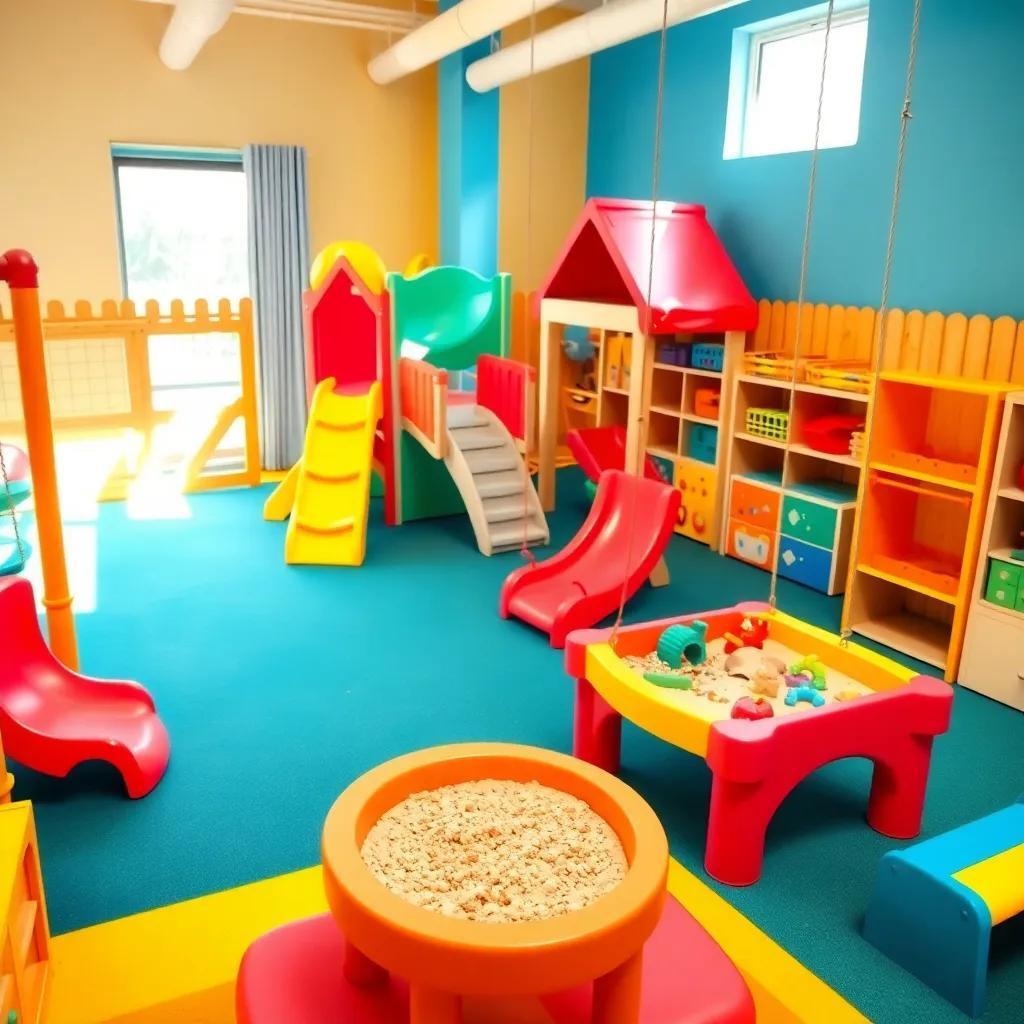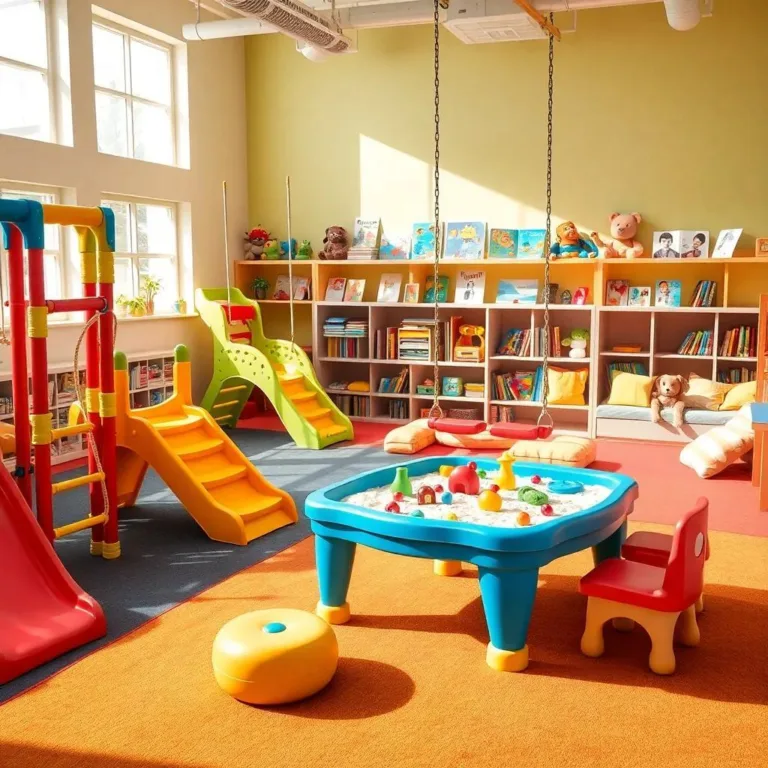Welcome to the fun-filled world of daycare play areas! Did you know that these vibrant spaces do more than just entertain? They play a huge role in helping kids grow and learn essential skills while having the time of their lives! Join me as we explore the benefits of play areas, safety tips, and how to create an engaging environment that promotes creativity and independence. Let’s dive in and discover the magic of play together!
Benefits of Play Areas for Child Development
Play areas in daycare are like little worlds of wonder, where children can explore, learn, and grow! When kids engage in play, they’re not just having fun; they’re busy building their physical, cognitive, and social skills. So, let’s look at some amazing benefits of play areas for child development!
- Physical Development: Children need to move, jump, and run to stay healthy. Play areas help them develop their gross motor skills. Activities like climbing, swinging, or sliding strengthen their muscles and improve balance. Plus, it’s a great way for them to burn off that endless energy! Who doesn’t love to see kids laughing and playing?
- Cognitive Growth: Did you know that play can boost brainpower? Through play, kids learn to solve problems, make decisions, and understand the world around them. When they build with blocks or navigate a maze, they’re using their critical thinking skills. It’s like giving their brains a workout!
- Social Skills: Play areas provide a perfect setting for children to interact with their peers. They learn to share, cooperate, and communicate. These skills are key for teamwork later in life. Let’s face it—wouldn’t we all want our kids to be great at making friends?
- Emotional Development: Play isn’t just about being active; it also helps children express their feelings. Whether they’re pretending to be superheroes or playing house, kids can explore different emotions. This kind of imaginative play builds empathy and understanding of others.
- Imagination and Creativity: A well-designed play area sparks creativity! Kids can dream up new worlds and scenarios while they play. Imaginative play not only entertains them but also encourages innovation. Who knows? The next great inventor might just be creating something fabulous in the play area!
Play areas are so much more than just a spot to play—they’re a magical place for kids to learn and grow! It’s all about having fun while developing essential skills that will last a lifetime!
Safety Measures for Daycare Play Areas
When it comes to kids playing, safety is my number one priority! Creating a secure environment in daycare play areas is a must. After all, happy and safe kids make for happy parents! Let’s dive into some essential safety measures we can take to keep our little ones safe while they explore:
- Equipment Safety: Always choose play equipment that meets safety standards. Check for any sharp edges or loose parts. You want to make sure everything is securely anchored and safe for kids to use.
- Surface Safety: What’s underfoot matters! Soft surfaces like rubber mulch or engineered wood fiber provide cushioning in case of falls. It’s like having a cozy pillow ready to catch them!
- Regular Inspections: Make it a habit to conduct routine inspections of the play area. Look for wear and tear on equipment or surfaces. If something looks off, fix it right away. Think of it as giving the play area a little check-up!
- Safe Fall Zones: Create designated fall zones around all play equipment. It’s important to have enough space covered in soft material to cushion any tumbles. Let’s keep those bumps and bruises at bay!
- Supervision: Constant supervision is a game-changer! Staff should be trained to keep an eye on kids as they play. It helps prevent accidents and ensures that everyone is playing safely.
- Fencing and Gates: A secure fence keeps kids safe and sound within the play area. Make sure the gates are self-locking, so no little adventurers can wander off unexpectedly!
- Emergency Preparedness: Have a plan in place! Keeping first aid kits handy and ensuring that staff members know emergency procedures is essential. It gives peace of mind, knowing you’re ready for anything!
By implementing these safety measures, we create a fun and secure play environment that allows kids to explore, interact, and enjoy their time without worry. After all, a safe play area is a happy play area!

Choosing Age-Appropriate Equipment and Activities
When setting up a daycare play area, one of the most important tasks is selecting age-appropriate equipment and activities. This is key to ensuring that every child can learn, grow, and have a blast! Let’s break down how to make the best choices for our little explorers.
- For the Tots (Ages 1-3):
– Focus on soft play equipment like low climbers and gentle slides. These let younger children build their strength and coordination without fear of falling hard.
– Introduce toys that encourage fine motor skills, such as stacking blocks, simple puzzles, and shape sorters. These activities help develop dexterity and hand-eye coordination.
- For Preschoolers (Ages 4-5):
– Include more challenging equipment like climbing structures and larger slides. These can help build confidence and encourage physical activity!
– Offer imaginative play materials such as costumes, dollhouses, and tool sets. These encourage creativity and storytelling!
- For Big Kids (Ages 6 and up):
– Invite cooperative games and team sports to help promote social interaction. Think about adding things like kickballs or frisbees.
– Provide opportunities for building projects, like Legos or art stations, which challenge cognitive skills while being fun!
By choosing the right equipment and activities, I can create an engaging play area that matches each child’s developmental needs. This thoughtful approach ensures that kids are not just playing, but are also learning and growing through their experiences. Happy playing, everyone!
Incorporating Diversity and Inclusion in Play
Creating a daycare play area that reflects diversity and inclusion is essential! It’s all about ensuring that every child feels represented and respected. When we celebrate differences, we help children grow into caring and understanding individuals. Here are some friendly tips on how to make this happen:
- Cultural Representation:
– Stock the play area with toys, books, and materials that reflect various cultures and backgrounds. Think about introducing dolls or action figures that represent different ethnicities. It shows kids that everyone is valued!
- Gender-Neutral Play:
– Offer a wide range of toys that encourage all kids to explore their interests without the constraints of gender stereotypes. For instance, let’s have building toys, art supplies, and action figures accessible to everyone!
- Disability-Inclusive Equipment:
– Include play equipment that is accessible to children with disabilities. This can be things like ramps for wheelchairs or sensory play stations. Making sure everyone can participate is important!
- Diverse Learning Materials:
– Incorporate books and stories that showcase characters from various backgrounds and abilities. Using storytelling can be a powerful way to teach empathy and understanding!
By embracing diversity and inclusion in the play area, I can foster an environment where every child feels welcomed and encouraged to express themselves. This commitment not only enriches their play experience but also plants the seeds for a brighter, more inclusive future!
Encouraging Independent Play in Early Childhood
Ah, independent play—it’s a beautiful thing! Encouraging kids to engage in play on their own shapes their confidence and creativity. Plus, it gives them the chance to explore the world at their own pace. Here are some fun ways to promote independent play in the daycare environment:
- Create Inviting Spaces:
– Design specific areas for different activities, like a cozy reading nook, an art station, or a building zone. Each space should entice kids to dive into their imaginations. Cozy corners with pillows are always a hit!
- Offer Open-Ended Materials:
– Provide a variety of materials that can spark creativity. Think about things like building blocks, art supplies, and loose parts. These allow children to create whatever their minds can dream up!
- Rotate Play Materials:
– Keep things fresh by regularly changing up the materials available for play. This keeps kids curious and excited about exploring new activities!
- Encourage Decision-Making:
– Let children choose what they want to play with and whom they want to play with. This promotes independence and fosters a sense of ownership over their play experiences.
- Model Independent Play:
– Occasionally engage in independent play yourself! Show kids how to explore materials without needing adult help constantly. They’ll learn from observing you!
By encouraging independent play, I’m helping children develop important skills like problem-solving, decision-making, and self-regulation. They learn to entertain themselves, think critically, and express their creativity! Independence in play is not just fun; it’s a vital part of growing up!

